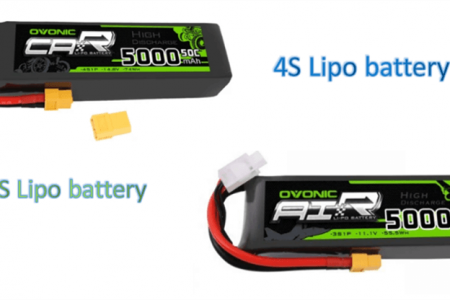In the world of RC enthusiasts, battery choice matters. The debate between 3S and 4S Lipo batteries is crucial.
Understanding the differences between 3S and 4S Lipo batteries can impact performance and experience. Whether you’re a beginner or a seasoned hobbyist, knowing which battery suits your needs helps optimize your RC vehicles. In this blog post, we will explore what sets these two options apart, providing you with the insights needed to make an informed decision.
From power output to weight considerations, each factor plays a role in your choice. So, let’s dive into the key aspects of 3S and 4S Lipo batteries and see which one fits your RC adventures best.
Introduction To Lipo Batteries
Lipo batteries come in different types. A 3S Lipo offers a lower voltage compared to a 4S Lipo. Choosing between them depends on your power needs.
### Introduction to Lipo BatteriesLipo batteries, or Lithium Polymer batteries, are a game-changer in the world of RC cars, drones, and other high-tech gadgets. They offer a perfect blend of lightweight design and high energy density, making them the go-to choice for hobbyists and professionals alike.But what makes Lipo batteries so special? And why should you care about the difference between 3S and 4S Lipo batteries? Let’s dive in.###What Are Lipo Batteries?
Lipo batteries are a type of rechargeable battery made from lithium polymer. Unlike traditional batteries, they can be molded into various shapes and sizes, allowing for more flexibility in design.They pack a punch with higher energy density, meaning they can store more power in a smaller space. This makes them ideal for applications where weight and space are crucial, like in drones and RC cars.You might have seen Lipo batteries in your smartphone or laptop. They are everywhere, but their real magic shines in the RC and drone world.###Importance In Rc And Drones
Ever wondered why your RC car zooms past others or why your drone hovers longer? It’s likely due to the Lipo battery inside. These batteries provide the high current needed for powerful motors, making your gadgets faster and more efficient.In RC cars, a good Lipo battery can mean the difference between winning and losing a race. They deliver consistent power, ensuring your car performs at its best.For drones, Lipo batteries are even more critical. They need to be lightweight to keep the drone airborne and powerful enough to handle all the onboard electronics. Imagine capturing stunning aerial footage without worrying about battery life—sounds great, right?Choosing between 3S and 4S Lipo batteries can be tricky. A 3S battery has three cells, while a 4S has four. More cells mean more voltage and power but also more weight. What’s the best choice for you? That depends on your specific needs and how you plan to use your RC car or drone.Have you ever tried using different types of batteries in your gadgets? How did it go? Share your experiences in the comments below!Basics Of 3s And 4s Lipo Batteries
Understanding the basics of 3S and 4S LiPo batteries is essential for RC enthusiasts. These batteries power drones, cars, and other RC vehicles. The choice between 3S and 4S can affect performance, speed, and battery life. Let’s break down their differences.
Voltage Differences
3S LiPo batteries have three cells in series. Each cell provides 3.7 volts. So, a 3S battery offers 11.1 volts. In contrast, 4S LiPo batteries have four cells in series. They provide 14.8 volts.
Higher voltage means more power. A 4S battery delivers more speed and torque. This makes it suitable for high-performance RC vehicles. But, higher voltage can also mean more heat. Ensure your system can handle this power safely.
Capacity And Size
Capacity affects how long your battery lasts. It’s measured in milliamp hours (mAh). Both 3S and 4S batteries can have similar capacities. But, a 4S battery with the same capacity as a 3S will be larger and heavier.
Size and weight impact your vehicle’s balance and performance. A heavier battery might reduce flight time for drones. It can also affect handling in RC cars. Consider your vehicle’s design and purpose before choosing.
Performance Comparison
When choosing between a 3S and 4S Lipo battery for your RC model or drone, understanding the performance differences can be crucial. Whether you’re a beginner or a seasoned pilot, knowing how these batteries affect power output and flight time will help you make an informed decision. Let’s dive into the specifics and compare the performance of 3S and 4S Lipo batteries.
Power Output
Power output is a key factor in performance. A 4S Lipo battery provides higher voltage compared to a 3S Lipo. This translates to more power for your motors, resulting in faster speeds and stronger thrust.
Imagine you’re racing your drone. With a 4S battery, you’ll notice quicker acceleration and greater top speed, giving you an edge over competitors. However, this increased power also means your motors will work harder, which might lead to quicker wear and tear.
In contrast, a 3S battery offers a more balanced power output. It’s ideal for beginners or those who prefer a smoother, controlled flight experience. You still get decent speed, but it’s less aggressive than a 4S battery.
Flight Time
Flight time is another critical aspect to consider. Generally, 3S Lipo batteries provide longer flight times compared to 4S batteries. This is because the 3S battery draws less current, allowing for extended use.
If you’re into aerial photography or just enjoying leisurely flights, a 3S battery might be more suitable. You get more time in the air to capture stunning shots or explore surroundings.
On the other hand, the 4S battery, while powerful, tends to drain faster due to higher energy consumption. This means shorter flight times, which can be a trade-off for the added performance.
Think about your flying goals. Are you aiming for speed and agility or longer, more stable flights? The answer will guide you towards the right battery choice.
Choosing between 3S and 4S Lipo batteries ultimately depends on your specific needs and flying style. What’s your priority? Speed or endurance? Consider these insights as you make your decision, and you’ll find the perfect battery to enhance your RC model or drone experience.

Credit: blog.ampow.com
Advantages Of 3s Lipo
When choosing the right battery for your RC vehicle, drone, or other electronic projects, you might be torn between a 3S and a 4S Lipo. Each has its own set of benefits, but today, we’re going to dive into the advantages of using a 3S Lipo battery. Whether you’re a beginner or an experienced hobbyist, understanding these benefits can help you make a more informed decision.
Cost Efficiency
One of the most significant advantages of 3S Lipo batteries is their cost efficiency. They are generally less expensive than their 4S counterparts. This makes them an excellent choice if you’re just starting out or working within a budget.
Consider the overall cost of your project. By opting for a 3S Lipo, you can save money that can be spent on other essential components. This can be particularly beneficial if you’re trying to build multiple units or experiment with different setups.
Weight Considerations
Weight is another crucial factor when it comes to choosing a battery. 3S Lipo batteries are typically lighter than 4S batteries. This can make a significant difference in the performance and handling of your RC vehicle or drone.
For example, in racing drones, a lighter battery can result in quicker acceleration and better maneuverability. The reduced weight can also lead to longer flight times, which is always a plus.
Is weight a key concern for your project? If so, a 3S Lipo might be the way to go.
So, what do you think? Will you be considering a 3S Lipo for your next project? Share your thoughts and experiences in the comments below. We’d love to hear from you!
Advantages Of 4s Lipo
Choosing between a 3S and a 4S Lipo battery can be challenging. Yet, the 4S Lipo battery has unique advantages. It stands out in performance and power. Let’s explore the key benefits of a 4S Lipo battery.
Higher Speed
The 4S Lipo battery offers higher voltage. This means your RC vehicle or drone will run faster. Higher speed translates to thrilling experiences. It ensures you get the most out of your device. Whether racing or flying, the speed boost is noticeable.
Better Thrust
Thrust is crucial for lifting and maneuvering. A 4S Lipo battery provides better thrust. This is due to its higher voltage and current output. Improved thrust means more control and agility. You can perform complex maneuvers with ease. Your device responds quicker to commands.

Credit: www.youtube.com
Suitable Applications
Choosing between a 3S and a 4S LiPo battery can be confusing, especially with so many options available. Each type has its advantages, making them suitable for different applications. Whether you’re a hobbyist or a professional, understanding the best use cases can help you make an informed decision.
Best Uses For 3s
3S LiPo batteries are ideal for beginners. They offer a good balance of power and control. If you’re flying smaller drones or using RC cars, a 3S battery can provide sufficient power without overwhelming you.
They’re also great for applications where long flight times are crucial. For instance, if you’re into aerial photography, a 3S battery can keep your drone in the air longer. This gives you more time to capture that perfect shot.
Another advantage is that they are generally lighter. This makes them suitable for smaller models where weight is a critical factor. Plus, they are often more affordable, which is a big win if you’re on a budget.
Best Uses For 4s
4S LiPo batteries are perfect for those needing extra power. If you’re into racing drones or high-speed RC cars, the 4S can give you that competitive edge. The extra voltage means more speed and better performance.
They’re also excellent for larger models. Bigger drones and RC vehicles can handle the additional weight and benefit from the increased power. This can make a significant difference in performance and speed.
However, they require more experience to handle properly. If you’re looking for a challenge and want to push your skills, a 4S battery can offer that. Just be prepared for the extra power and make sure your equipment can handle it.
Have you tried both 3S and 4S batteries? What differences did you notice in performance? Share your experiences and help others make the right choice!
Safety And Maintenance
3S Lipo batteries are safer and easier to maintain than 4S ones. Higher voltage in 4S can lead to overheating. Regular inspections and balanced charging are crucial for both types to ensure optimal performance and longevity.
When it comes to Lipo batteries, understanding safety and maintenance is crucial. Whether you’re using a 3S or 4S Lipo, following best practices can prevent accidents and extend battery life. Let’s dive into some essential tips for charging, storing, and maintaining your Lipo batteries.Charging Practices
Proper charging is the foundation of Lipo battery safety. Always use a charger designed for Lipo batteries. This ensures that the charging process is controlled and safe.Avoid overcharging. Overcharging can cause the battery to overheat and potentially catch fire. Set your charger to the correct voltage for your battery type—12.6V for a 3S Lipo and 16.8V for a 4S Lipo.Never leave charging batteries unattended. This simple step can prevent accidents. Use a fireproof charging bag for added safety.Storage Tips
Storing Lipo batteries correctly can prolong their lifespan. Store your batteries at room temperature. Extreme temperatures can damage them.Always store batteries at a partial charge. Fully charged or completely drained batteries deteriorate faster. Aim for around 3.8V per cell.Use a fireproof container for storage. This adds an extra layer of safety, especially if you have multiple batteries.Regularly check your batteries for damage. Swollen or punctured batteries should be disposed of safely. Never store damaged batteries.Safety and maintenance are not just about following rules. They’re about forming habits that protect you and your investment. What safety practices do you follow with your Lipo batteries? Share your tips in the comments!Choosing The Right Battery
Choosing between 3S and 4S Lipo batteries depends on your power needs. 3S batteries offer good balance for moderate use. 4S batteries provide higher power for demanding tasks.
Choosing the right battery for your needs can be tricky. Especially when deciding between 3S and 4S Lipo batteries. Both have their advantages. But which one fits your situation better? Let’s dive into the factors you should consider.Factors To Consider
First, consider the voltage. A 3S battery has a nominal voltage of 11.1V. A 4S battery has 14.8V. Higher voltage means more power. But do you need that extra power?Next, think about the weight. 4S batteries are usually heavier. This extra weight can affect your device’s performance. Especially in drones or other lightweight equipment.Also, consider the cost. 4S batteries tend to be more expensive. If you are on a budget, a 3S battery might be better.Personal Needs And Preferences
Your personal needs matter too. Are you using the battery for a hobby drone? A 3S battery might be enough. But if you need more speed and power, go for a 4S.Think about your experience level. If you are new to Lipo batteries, start simple. A 3S battery is easier to manage. Fewer risks involved.Lastly, consider your device. Some devices work better with specific batteries. Check your device’s specifications before making a decision.
Credit: www.youtube.com
Frequently Asked Questions
What Is The Difference Between 3s And 4s Lipo Battery?
A 3S LiPo battery has 3 cells, providing 11. 1 volts. A 4S LiPo battery has 4 cells, providing 14. 8 volts. The 4S battery offers more power and efficiency, suitable for high-performance applications.
How Low Can A 3s Lipo Battery Go?
A 3S LiPo battery should not go below 3. 0 volts per cell. This means a total of 9. 0 volts.
How Long Will A 3s 5000mah Lipo Last?
A 3S 5000mAh LiPo can last 10-20 minutes depending on usage, load, and efficiency of the device.
What Is The 80% Rule For Lipo Batteries?
The 80% rule for LiPo batteries advises not to discharge below 80% capacity. This extends battery lifespan and ensures safety.
What Is The Difference Between 3s And 4s Lipo?
The main difference is voltage. 3S has 11. 1V, while 4S has 14. 8V.
Conclusion
Choosing between 3S and 4S Lipo batteries depends on your needs. 3S Lipo offers good balance and longer flight times. 4S Lipo provides more power and speed. Consider your experience level and specific requirements. Beginners may prefer 3S for ease of use.
Experienced users might lean towards 4S for performance. Both options have their advantages. Make an informed decision based on your goals. Happy flying!






